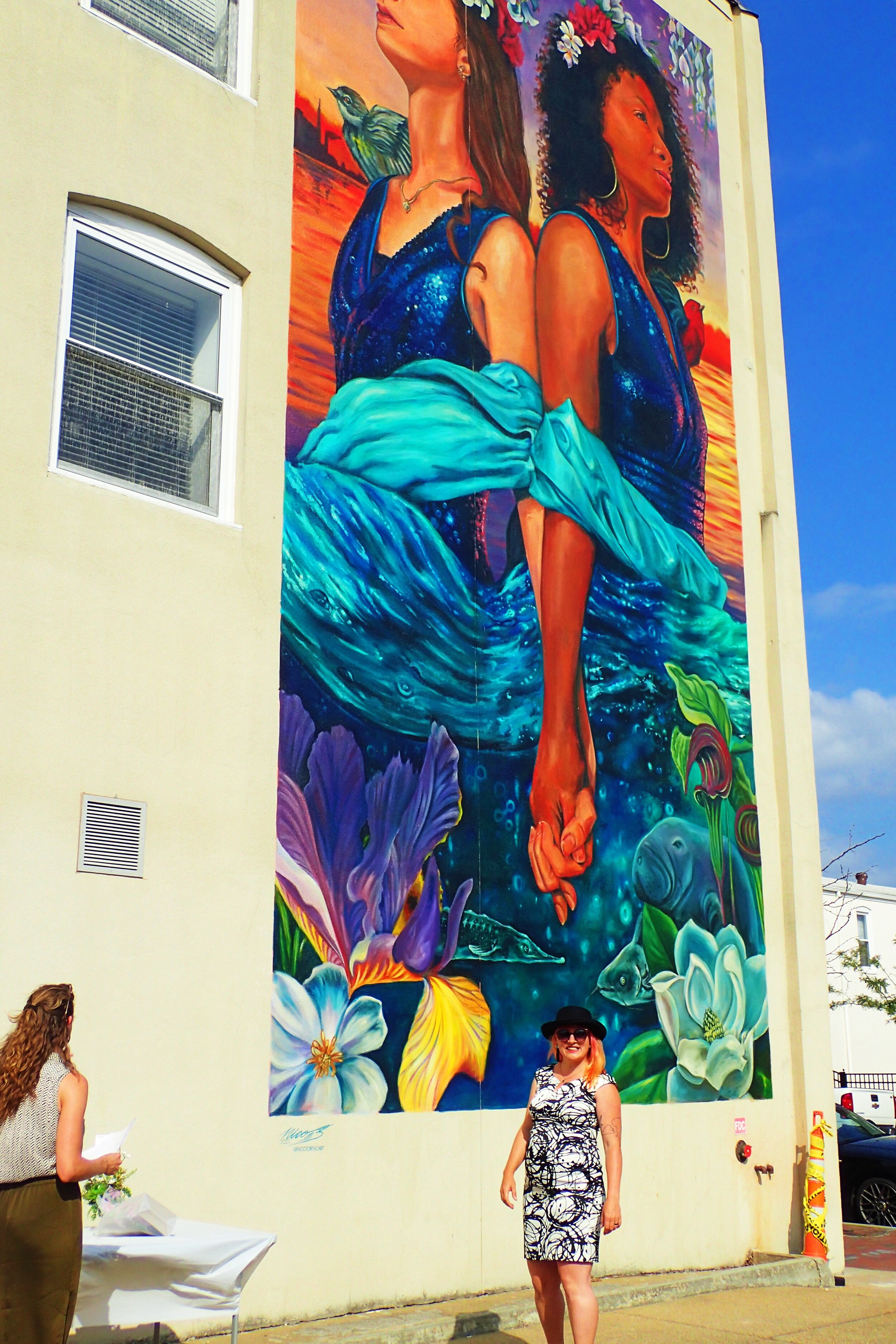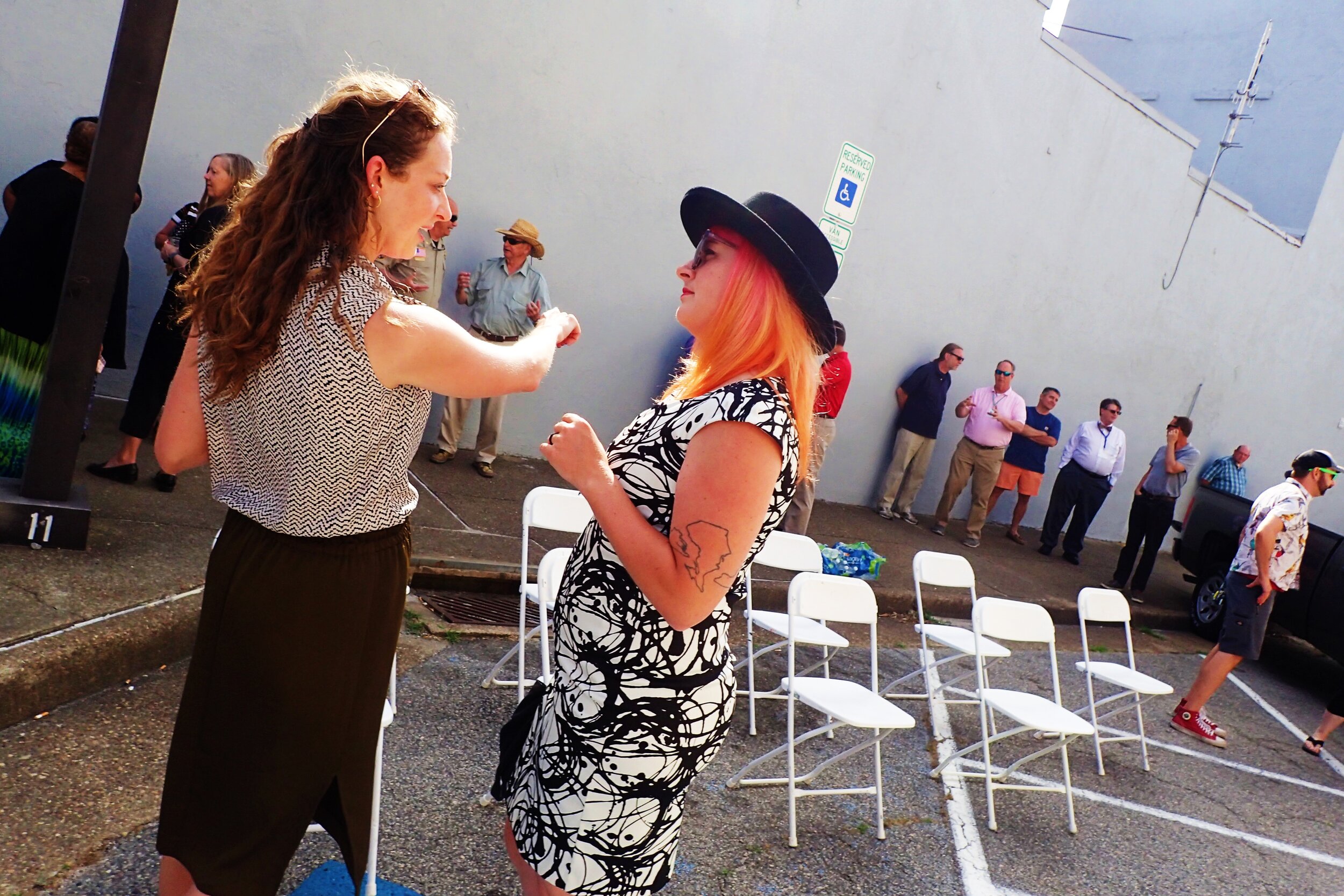A New Dawn For Hopewell
by Charles McGuigan 06.2021
Back in early May, Northside artist Nico Cathcart began painting a massive mural on the side of Butterworth Lofts at 245 East Broadway in downtown Hopewell. It would strive to capture the real story of this small city that sits at the confluence of the James and Appomattox Rivers, a city that thrived and then went bust on several occasions, a city at one time called the “Wonder City”.
Nico at the unveiling of her three-story mural, A New Dawn.
Three weeks later to the day, on a clear, warm evening, Nico’s three-story mural is unveiled. It’s a spectacular interpretation of this unique city that before its incorporation in 1916 was one of the world’s busiest ports, serving as the Union Army’s central supply depot during the Siege of Petersburg in the final year of the Civil War. Since its founding, Hopewell has been a city of immigrants—Czech, Italian, and Greek, primarily —many of whom settled here to work in a DuPont plant that manufactured dynamite, then later, during World War I, switched to the production of guncotton. It is the second oldest continuously inhabited English settlement in the United States, and in the years before the Civil War was built on the blood, sweat, and toil of enslaved Africans, who endured the horrors of a living hell for generations.
Nico is at center stage here on Broadway. Wearing a white-and-black shift dress with a complementary black boater on her colorful head of hair, Nico is talking with two young women—Hopewellians both—who are now part of the physical fabric of this small city. Nherie Tellado and Ari Calos were the models Nico used for her mural, which is called A New Dawn. Both young women, along with Nico, smile as they look up on the wall facing them, scaling all thirty feet of it with their eyes.
After a brief introduction by Heather Lyne, executive director of The Hopewell Downtown Partnership, the vice mayor of Hopewell delivers a few words, talking about the symbolism embodied in the mural. “The environmental aspects, the cultural aspects, the diversity aspects,” says Johnny Partin. “It really is a great symbol of everything that Hopewell was in the past, but more importantly about where we are going in the future, about us coming together, and a new dawn for our city.”
Heather Lyne then takes the microphone.
“It started in 2019 in the world before COVID time,” she begins. “Our former director applied for a grant to do several large mural projects in downtown Hopewell to show people how the face of downtown is changing. They sent out a request for proposal nationwide to try and find artists that would design a mural to speak to Hopewell’s history, but also to its future. They wanted it bright, energetic, and with an emphasis on the natural environment.”
Heather Lyne, executive director of The Hopewell Downtown Partnership, with Northside artist Nico Cathcart.
Once the world shut down, the project was put on hold. But this past January, Heather’s organization reached out to Nico. “We were fortunate Nico Cathcart was available,” says Heather. “I think she has blown us away with the amount of time and investment she’s put in to this project.”
And for Nico, before the drop of paint was applied, there was a lot of homework to be done. “She met with a lot of community members and leaders, business owners, and she met with naturalists at the Dutch Gap Conservation Area,” Heather says. “She put in her time with this design.”
After Heather reads Nico’s artist’s statement for A New Dawn, Nico herself addresses the crowd.
“I have to say a huge, big, warm, loving thank you to the community here,” she says. “It was a privilege to come and develop this project, and learn the history of this town and how it kind of relates to Virginia as a whole. It was quite a journey.”
Nico then gestures to the two young women by her side. “I am grateful for the two models who are here,” she says. “They were chosen because they represent the vibrant young community that’s developing here and has always been here. You ladies, thank you so much for your time and your patience. I have this great sense of love for this community after being here. Thank you so much.”
As the crowd parts, a number of us walk east on Broadway to Hopewell Street, then hang a right making our way over to Roja Taco Joint. As we stroll, Nico explains different elements of A New Dawn.
“There are a bunch of different symbols in the mural,” she says. “The two women are representative of the two rivers and how they meet in Hopewell which is why all the industry is here and why all the immigration is here on the Appomattox and the James. So I’m also using them as metaphors for community in the way that they are connected just like the river connects.”
And each woman wears a blue silk shawl, a nod to the artificial silk and gun cotton factories that once operated here.
“DuPont is in the background,” Nico says. “But it is in the back, and the women are facing out away from it to note that it’s in Hopewell’s history but we are looking forward away from it.”
The vast majority of images that appear in the mural were scooped from the natural world. “It is based on biodiversity,” says Nico. “So it’s showing a lot of local plant and animal species including the summer tanager and the golden throated warbler which are both found at Dutch Gap. While I was doing this piece, I had the privilege to interview a bunch conservationists in the.” Along with indigenous flora—pawpaw, May apple, Jack-in-the-Pulpit and Virginia wisteria—the mural highlights some aquatic fauna as well, including catfish, sturgeon, and even a manatee.
Ari Calos and Nherie Tellado, models for the mural.
“A lot of people don’t think of a manatee as a Virginia animal,” Nico says. “But what they don’t realize is that because this is a tidal area manatees actually do swim all the way up here on the James.” (As a matter of fact, just eight years ago several manatees were spotted in the Appomattox River not far from Hopewell.)
Nico then tells me why the two young Hopewell women were selected as models to represent the union of the two rivers. “Ari was chosen because she’s the daughter of Greek immigrants,” she says. “Her family has a long lineage and actually made up a lot of the work force for Dupont. That work force was mainly immigrants and Black people which is why I selected Nherie.”
During the course of her studies about Hopewell, Nico spent a fair amount of time with a woman who offered valuable insights into Hopewell’s racially checkered past. “I had the privilege to talk to Dr. Joanne Harris Lucas,” says Nico. “She told me a lot about the experience of growing up Black in Hopewell because there are two different Hopewells.”
Joanne Lucas’s father was the late Curtis W. Harris—minister, civil rights activist, politician—who fought hard all his life against white supremacy in Hopewell. In 1960, he was arrested and sentenced to sixty days in jail for his role in a sit-in at the segregated Georges' Drugstore. That same year he spearheaded a protest against Hopewell’s segregated swimming pool that culminated in the pools closure. He was a champion of liberty, a real hero. During a peaceful demonstration he led against Hopewell’s plan to build a landfill in Rosedale, a Black community in the city, he squared off with the local ku klux koneheads on the steps of City Hall. Throughout the Civil Rights Movement, he was arrested for civil disobedience a total of thirteen times.
In late March of 1962, Dr. Martin Luther King, along with more than a hundred 100 Virginia ministers and laymen, accompanied Reverend Harris at a bogus contempt trial. Reverend Harris marched with Dr. King on Washington the following year, and two year later joined Dr. King in his march from Selma to Montgomery. He never stopped fighting for justice. He was later elected to City Council, and then mayor of Hopewell. He was leading Hopewell to a brighter future.
“One of the ideas behind this mural is the two communities coming together and trying to work together,” Nico tells me as we approach the patio of the taco joint and an absolutely diverse crowd chowing down on tacos and sipping margaritas.



